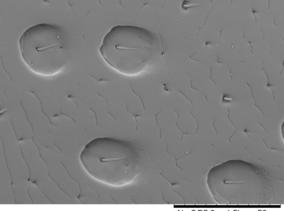You are here
Taxon Pages
Cephaloleia dilaticollis Baly, 1858
Nomenclature
-
Subfamily: CassidinaeGenus: Cephaloleia
SUMMARY
Egg
Cephaloleia dilaticollis lays eggs on the petioles and rolled leaves of their host plants. This species lays eggs singly or in clusters of 2 or more. During oviposition, eggs can be covered with frass. Eggs are in average 2.2 X 1.2 mm long. Mean time to eclosion is 7.4 days.
Larva
Newborn larvae are white and translucent. Larvae are ca. 2 mm long when born. First instar larvae are pale yellow. Second instar larvae display a characteristic black dorsal pattern.
Pupae
Larvae pupate after ca. 32.8 days. Larvae pupate inside the second instar larval exuviae. Pupae of species display distinctive ornaments.
Adults
Adults emerge from pupation after ca. 16.6 days. Adults are reddish brown, eyes and apex of antennae darker. Head: faint medial carina; sparsely punctate; frons not projecting; eyes black. Antenna: apical four antennomeres black, rest yellow; antennomere 1 obovate, subequal to 3; 2 transverse; 3 cylindrical; 4-10 transverse, decreasing in length; 11 pointed at apex. Pronotum: twice as wide as long; sparsely punctate; side dilated, slightly rounded; anterior angle nearly truncate; posterior angle rectangular; pronotal length 0.7-1.0 mm (n=50); pronotal width 1.9 mm. Scutellum: triangular; impunctate. Elytron: scarcely wider than base of pronotum; side margined, smooth; apices obtusely rounded, subtruncate; slightly convex, flattened along suture; slightly deflected behind humerus; finely punctate-striate; puncture rows converge and unite at apex; last segment of pygidium u-shpaed in male, truncate in female; elytral length 3.0-3.6 mm; elytral width 2.1 mm. Venter: prosternum rugose in middle; meso- and metasterna punctate laterally; abdominal sterna 1 and 2 fused in middle; sterna 3-5 setose; last abdominal sternite deeply sinuate in male, obtusely rounded in female. Leg: punctate; tibia darker at base, fringe of setae at apex. Total length: 4.3-4.6 mm; females are larger than males.
Sexual dimorphism
This species displays marked sexual dimorphism in the shape of the last abdominal sternite and the pygidium. The end of the last sternite in males is u-shaped. In females the last sternite is truncate (Garcia-Robledo et al. 2010).






